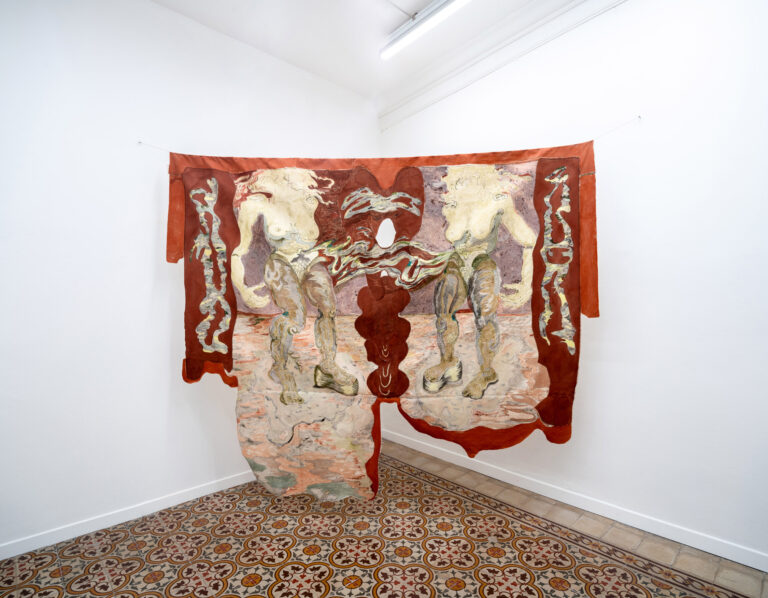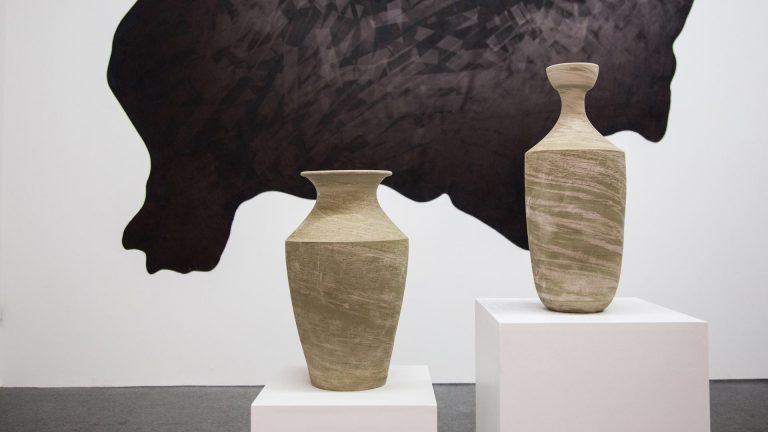Artist: Eva Kot’átková
Exhibition title: The Dream Machine is Asleep
Curated by: Roberta Tenconi
Venue: Pirelli HangarBicocca, Milan, Italy
Date: February 15 – July 22, 2018
Photography: all images copyright and courtesy of the artist and Pirelli HangarBicocca
Pirelli HangarBicocca presents “The Dream Machine is Asleep,” from February 15 to July 22, 2018, the solo show by Eva Kot’átková, conceived as a path of imagery and words, a labyrinthine and surreal world that invites us to produce dreams and develop our imagination, highlighting individual fantasies, fears and the challenges of contemporary society.
For the exhibition “The Dream Machine is Asleep,” curated by Roberta Tenconi, Eva Kot’átková has developed an original and immersive project in which existing works are placed side by side with new productions, including installations, sculptures, over-sized objects, collages and performances. Starting from a vision of the human body as a machine, a great organism of which the functioning requires checking, regeneration and rest, and from the idea of sleep as a moment in which, through our dreams, we come up with new visions and enter parallel worlds, the exhibition explores our most intimate projections and thoughts, as well as the angst and disorientation of contemporary living.
The Artist
Through her works, Eva Kot’átková (Prague, 1982), one of the most acclaimed artists of her generation, questions contemporary society and its dysfunctions, highlighting the profound impact on our behavior and on our identity of conventions, institutional rules and educational systems.
Many works which focus on the body and its relationship with objects are created by the artist through a visual language which draws both on the avant-gardes of the early 20th century, such as Surrealism and Dadaism, as well as on female artists like Lygia Clark and Louise Bourgeois, whose works interpret the concept of femininity and diversity.
Having grown up in a historical moment of great transformation in what was then Czechoslovakia—at the end of the Cold War, with the fall of the Berlin Wall in 1989 and of the USSR—the artist also draws inspiration from her own experiences to analyze the comparison between the intimate dimension of each individual and the behavioral frameworks imposed in a totalitarian system, which may even go as far as to condition both the body and mind.
In this context, for Eva Kot’átková childhood, a recurring theme in various works, constitutes a preferred way of observing reality. Through the use of imagery, objects and practices taken from books on psychology, pedagogy, medicine, the social sciences and theater techniques such as the psychodrama, the artist has often worked with children and kids from both elementary and junior high schools, creating workshops of which the outcome is fully incorporated in her work. The same goes for The Dream Machine is Asleep: the installation created especially for the spaces of the Pirelli HangarBicocca, and which provides the title for the whole show.
The Exhibition
At the center of “The Dream Machine is Asleep” there is the installation of the same name: a gigantic bed, at the base of which there is what the artist defines as an office for the creation of dreams. With this work, Eva Kot’átková continues her research into the systems that regulate our lives, countering them with imagery from the universe of childhood in order to make up for the lack or the loss of imagination. Imagine that people are no longer able to dream – reads the artist’s invitation on her search for young collaborators in order to create an archive of dreams made available to the visitors of the Milanese show. Not only during the night, but also during the day, people lack imagination. Here lies your task on this project: to provide dreams and ideas for all those who spend sleepless nights, or those who have to face monotonous working days with strict timetables and no unexpected events. You shall become the engineers (constructors) of the dreams of others, the suppliers of dreams.
In order to access the exhibition space, the visitors are invited to pass through the work titled Stomach of the World (2017), an allegory of the world, described as a chaotic organism which alternates between processes of ravenous assimilation and moments of stasis, empathy or clashes between its inhabitants, and periods of control, digestion, expulsion and recycling of the ‘waste’ produced, in other words its phobias and states of angst. The work, comprising of a video presented inside an installation which may be accessed by visitors and which takes on the stylized design of a stomach, makes use of protagonists and imagery taken from the world of childhood and mythology.
Inside the space of the Shed at the Pirelli HangarBicocca, numerous over-sized objects punctuate the entire show, placing the public face to face with imagery halfway between fantasy literature, the neurological sciences and psychiatric disorders. Alongside a series of seven enormous metal heads (Heads, 2018), which are activated and completed by the presence of performers who relate to them motionlessly, just by posing, visitors may also browse through the pages of books standing some two meters high. These books (Diaries, 2018) feature small sculptures and collages—a medium broadly adopted by Surrealism and much loved by Eva Kot’átková by virtue of its intrinsic nature of joining together different fragments and elements to create new compositions—and represent a diary in which thoughts and notes around disfunctions and peculiarities of the todays world are collected.
In The Theatre of Speaking Objects (2012), on the other hand, eleven everyday objects and furnishings such as a vase, a door or a wall adopt anthropomorphic characteristics, becoming the bearers of hidden traumas. The work was presented at the 18th Biennale of Sydney and is inspired by a series of sketches by the Czech architect Jiri Kroha (1893-1974), who in the ’20s had imagined a theater play using simple everyday tools to then endow with human voices and characteristics. In the cacophony of voices, which all speak different languages, and in the use of objects as a surrogate of the human body, Eva Kot’átková highlights situations in which it is not possible to express oneself freely, instead providing the chance to do so through this form of indirect communication, using objects as mediators.
The entire show is conceived as an organism which, through programmed performances, is brought to life and inhabited by figures who wander through the space, activating the works through simple static actions, with more complex choreographies or through the recounting of ad-libbed oral narratives. Thus, in Asking the Hair about Scissors (2018), from an anomalous and surreal hairdresser, visitors may be witness to tales freely composed by Eva Kot’átková on the basis of news stories. By asking to do away with a part of one’s own body—the hair—the artist explores the notion of fragmentation.
Eva Kot’átková
Eva Kot’átková (Prague, 1982) lives and works in Prague. She studied at the Academy of Fine Arts in Prague, at the San Francisco Art Institute and at the Akademie der Bildenden Künste in Vienna. She has displayed her work in various institutions, including: Haus 21 – Museum of Contemporary Art, Vienna (2017); K21, Düsseldorf, Migros Museum, Zurich, and Ming Contemporary Art Museum, Shanghai (2016); MIT List Visual Art’s Center, Cambridge, Massachusetts (2015); Staatliche Kunsthalle Baden-Baden, Baden-Baden, and Schinkel Pavillon, Berlin (2014), and the Wroclaw Museum of Contemporary Art, Wroclaw (2013). She has taken part in international events, such as 55th Venice Biennale and 5th Moscow Biennale of Contemporary Art (2013); 18th Biennale of Sidney (2012), and 11th Lyon Biennale of Contemporary Art (2011). In February 2018 she has also taken part in the 47th International Film Festival of Rotterdam.
Eva Kot’átková, Feeding the Cleaning Machine with what Others Didn’t Finish, 2018, installation view at Pirelli HangarBicocca, Milan, 2018. Commissioned and produced by Pirelli HangarBicocca, Milan. Courtesy of the artist. Photo: Agostino Osio
Eva Kot’átková, Head no.3: Nervous Head (Insomnia), 2018, installation view at Pirelli HangarBicocca, Milan, 2018. Commissioned and produced by Pirelli HangarBicocca, Milan. Courtesy of the artist. Photo: Agostino Osio
Eva Kot’átková, Diary no.3 (I-Machine), 2018, installation view at Pirelli HangarBicocca, Milan, 2018. Commissioned and produced by Pirelli HangarBicocca, Milan. Courtesy of the artist. Photo: Agostino Osio
Eva Kot’átková, Diary no.3 (I-Machine), 2018 (detail). Commissioned and produced by Pirelli HangarBicocca, Milan. Courtesy of the artist. Photo: Agostino Osio
Eva Kot’átková, Head no.2: Busy Head (Hearing voices hallucination), 2018, installation view at Pirelli HangarBicocca, Milan, 2018. Commissioned and produced by Pirelli HangarBicocca, Milan. Courtesy of the artist. Photo: Agostino Osio
Eva Kot’átková, The Dream Machine is Asleep, 2018, installation view at Pirelli HangarBicocca, Milan, 2018. Commissioned and produced by Pirelli HangarBicocca, Milan. Courtesy of the artist. Photo: Agostino Osio
Eva Kot’átková, The Dream Machine is Asleep, 2018, installation view at Pirelli HangarBicocca, Milan, 2018. Commissioned and produced by Pirelli HangarBicocca, Milan. Courtesy of the artist. Photo: Agostino Osio
Eva Kot’átková, Cutting the Puppeteer’s Strings with Paper Teeth (Brief History of Daydreaming and String Control), 2016, installation view at Pirelli HangarBicocca, Milan, 2018. Kunstmuseen Krefeld, Collection of the Freunde der Kunstmuseen Krefeld e.V Courtesy of the artist and Pirelli HangarBicocca, Milan. Photo: Agostino Osio
Eva Kot’átková, Cutting the Puppeteer’s Strings with Paper Teeth (Brief History of Daydreaming and String Control), 2016 (detail). Kunstmuseen Krefeld, Collection of the Freunde der Kunstmuseen Krefeld e.V Courtesy of the artist and Pirelli HangarBicocca, Milan. Photo: Agostino Osio
Eva Kot’átková, The Dream Machine is Asleep, 2018, installation view at Pirelli HangarBicocca, Milan, 2018. Commissioned and produced by Pirelli HangarBicocca, Milan. Courtesy of the artist. Photo: Agostino Osio
Eva Kot’átková, The Dream Machine is Asleep, 2018, installation view at Pirelli HangarBicocca, Milan, 2018. Commissioned and produced by Pirelli HangarBicocca, Milan. Courtesy of the artist. Photo: Agostino Osio
Eva Kot’átková, “The Dream Machine is Asleep”, exhibition view at Pirelli HangarBicocca, Milan, 2018. Courtesy of the artist and Pirelli HangarBicocca, Milan. Photo: Agostino Osio
Eva Kot’átková, “The Dream Machine is Asleep”, exhibition view at Pirelli HangarBicocca, Milan, 2018. Courtesy of the artist and Pirelli HangarBicocca, Milan. Photo: Agostino Osio
Eva Kot’átková, Diary no.2 (I-Animal), 2018, installation view at Pirelli HangarBicocca, Milan, 2018. Commissioned and produced by Pirelli HangarBicocca, Milan. Courtesy of the artist. Photo: Agostino Osio
Eva Kot’átková, Diary no.2 (I-Animal), 2018 (detail). Commissioned and produced by Pirelli HangarBicocca, Milan. Courtesy of the artist. Photo: Agostino Osio
Eva Kot’átková, Diary no.2 (I-Animal), 2018 (detail). Commissioned and produced by Pirelli HangarBicocca, Milan. Courtesy of the artist. Photo: Agostino Osio
Eva Kot’átková, Stomach of the World, 2017, installation view at Pirelli HangarBicocca, Milan, 2018. Courtesy of the artist and Pirelli HangarBicocca, Milan. Photo: Agostino Osio
Eva Kot’átková, Stomach of the World, 2017, installation view at Pirelli HangarBicocca, Milan, 2018. Courtesy of the artist and Pirelli HangarBicocca, Milan. Photo: Agostino Osio
Eva Kot’átková, Stomach of the World, 2017, installation view at Pirelli HangarBicocca, Milan, 2018. Courtesy of the artist and Pirelli HangarBicocca, Milan. Photo: Agostino Osio

























